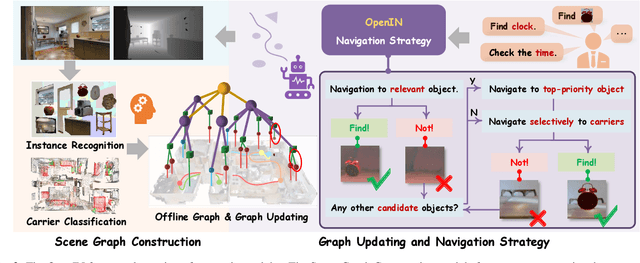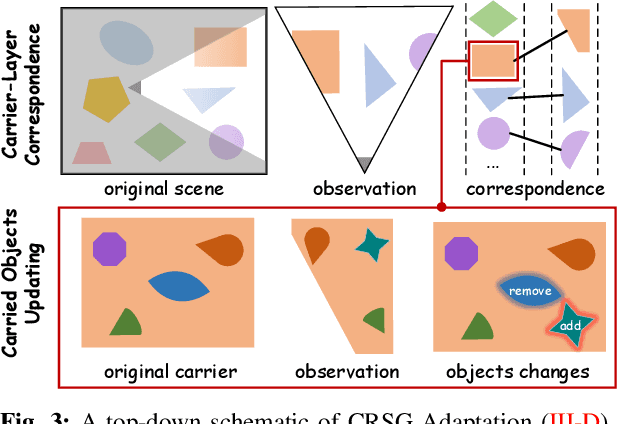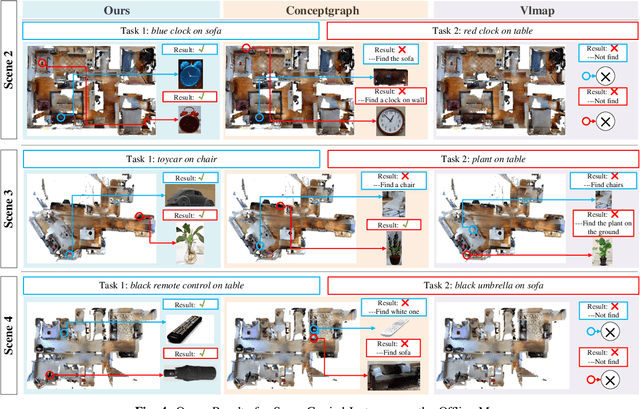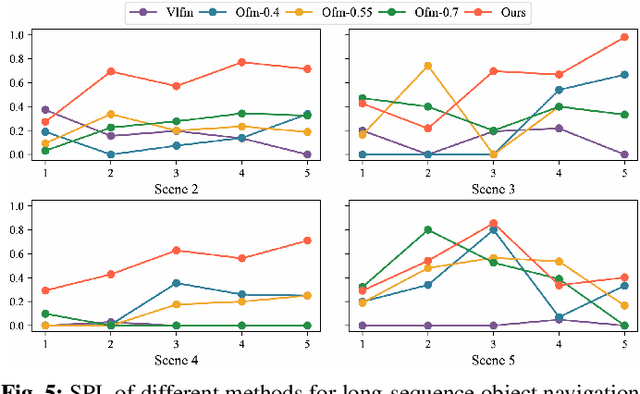Yufeng Yue
OmniMap: A General Mapping Framework Integrating Optics, Geometry, and Semantics
Sep 09, 2025Abstract:Robotic systems demand accurate and comprehensive 3D environment perception, requiring simultaneous capture of photo-realistic appearance (optical), precise layout shape (geometric), and open-vocabulary scene understanding (semantic). Existing methods typically achieve only partial fulfillment of these requirements while exhibiting optical blurring, geometric irregularities, and semantic ambiguities. To address these challenges, we propose OmniMap. Overall, OmniMap represents the first online mapping framework that simultaneously captures optical, geometric, and semantic scene attributes while maintaining real-time performance and model compactness. At the architectural level, OmniMap employs a tightly coupled 3DGS-Voxel hybrid representation that combines fine-grained modeling with structural stability. At the implementation level, OmniMap identifies key challenges across different modalities and introduces several innovations: adaptive camera modeling for motion blur and exposure compensation, hybrid incremental representation with normal constraints, and probabilistic fusion for robust instance-level understanding. Extensive experiments show OmniMap's superior performance in rendering fidelity, geometric accuracy, and zero-shot semantic segmentation compared to state-of-the-art methods across diverse scenes. The framework's versatility is further evidenced through a variety of downstream applications, including multi-domain scene Q&A, interactive editing, perception-guided manipulation, and map-assisted navigation.
FMimic: Foundation Models are Fine-grained Action Learners from Human Videos
Jul 28, 2025Abstract:Visual imitation learning (VIL) provides an efficient and intuitive strategy for robotic systems to acquire novel skills. Recent advancements in foundation models, particularly Vision Language Models (VLMs), have demonstrated remarkable capabilities in visual and linguistic reasoning for VIL tasks. Despite this progress, existing approaches primarily utilize these models for learning high-level plans from human demonstrations, relying on pre-defined motion primitives for executing physical interactions, which remains a major bottleneck for robotic systems. In this work, we present FMimic, a novel paradigm that harnesses foundation models to directly learn generalizable skills at even fine-grained action levels, using only a limited number of human videos. Extensive experiments demonstrate that our FMimic delivers strong performance with a single human video, and significantly outperforms all other methods with five videos. Furthermore, our method exhibits significant improvements of over 39% and 29% in RLBench multi-task experiments and real-world manipulation tasks, respectively, and exceeds baselines by more than 34% in high-precision tasks and 47% in long-horizon tasks.
MCOO-SLAM: A Multi-Camera Omnidirectional Object SLAM System
Jun 18, 2025Abstract:Object-level SLAM offers structured and semantically meaningful environment representations, making it more interpretable and suitable for high-level robotic tasks. However, most existing approaches rely on RGB-D sensors or monocular views, which suffer from narrow fields of view, occlusion sensitivity, and limited depth perception-especially in large-scale or outdoor environments. These limitations often restrict the system to observing only partial views of objects from limited perspectives, leading to inaccurate object modeling and unreliable data association. In this work, we propose MCOO-SLAM, a novel Multi-Camera Omnidirectional Object SLAM system that fully leverages surround-view camera configurations to achieve robust, consistent, and semantically enriched mapping in complex outdoor scenarios. Our approach integrates point features and object-level landmarks enhanced with open-vocabulary semantics. A semantic-geometric-temporal fusion strategy is introduced for robust object association across multiple views, leading to improved consistency and accurate object modeling, and an omnidirectional loop closure module is designed to enable viewpoint-invariant place recognition using scene-level descriptors. Furthermore, the constructed map is abstracted into a hierarchical 3D scene graph to support downstream reasoning tasks. Extensive experiments in real-world demonstrate that MCOO-SLAM achieves accurate localization and scalable object-level mapping with improved robustness to occlusion, pose variation, and environmental complexity.
DINO-CoDT: Multi-class Collaborative Detection and Tracking with Vision Foundation Models
Jun 09, 2025Abstract:Collaborative perception plays a crucial role in enhancing environmental understanding by expanding the perceptual range and improving robustness against sensor failures, which primarily involves collaborative 3D detection and tracking tasks. The former focuses on object recognition in individual frames, while the latter captures continuous instance tracklets over time. However, existing works in both areas predominantly focus on the vehicle superclass, lacking effective solutions for both multi-class collaborative detection and tracking. This limitation hinders their applicability in real-world scenarios, which involve diverse object classes with varying appearances and motion patterns. To overcome these limitations, we propose a multi-class collaborative detection and tracking framework tailored for diverse road users. We first present a detector with a global spatial attention fusion (GSAF) module, enhancing multi-scale feature learning for objects of varying sizes. Next, we introduce a tracklet RE-IDentification (REID) module that leverages visual semantics with a vision foundation model to effectively reduce ID SWitch (IDSW) errors, in cases of erroneous mismatches involving small objects like pedestrians. We further design a velocity-based adaptive tracklet management (VATM) module that adjusts the tracking interval dynamically based on object motion. Extensive experiments on the V2X-Real and OPV2V datasets show that our approach significantly outperforms existing state-of-the-art methods in both detection and tracking accuracy.
GaussianGraph: 3D Gaussian-based Scene Graph Generation for Open-world Scene Understanding
Mar 06, 2025Abstract:Recent advancements in 3D Gaussian Splatting(3DGS) have significantly improved semantic scene understanding, enabling natural language queries to localize objects within a scene. However, existing methods primarily focus on embedding compressed CLIP features to 3D Gaussians, suffering from low object segmentation accuracy and lack spatial reasoning capabilities. To address these limitations, we propose GaussianGraph, a novel framework that enhances 3DGS-based scene understanding by integrating adaptive semantic clustering and scene graph generation. We introduce a "Control-Follow" clustering strategy, which dynamically adapts to scene scale and feature distribution, avoiding feature compression and significantly improving segmentation accuracy. Additionally, we enrich scene representation by integrating object attributes and spatial relations extracted from 2D foundation models. To address inaccuracies in spatial relationships, we propose 3D correction modules that filter implausible relations through spatial consistency verification, ensuring reliable scene graph construction. Extensive experiments on three datasets demonstrate that GaussianGraph outperforms state-of-the-art methods in both semantic segmentation and object grounding tasks, providing a robust solution for complex scene understanding and interaction.
OpenGS-SLAM: Open-Set Dense Semantic SLAM with 3D Gaussian Splatting for Object-Level Scene Understanding
Mar 03, 2025



Abstract:Recent advancements in 3D Gaussian Splatting have significantly improved the efficiency and quality of dense semantic SLAM. However, previous methods are generally constrained by limited-category pre-trained classifiers and implicit semantic representation, which hinder their performance in open-set scenarios and restrict 3D object-level scene understanding. To address these issues, we propose OpenGS-SLAM, an innovative framework that utilizes 3D Gaussian representation to perform dense semantic SLAM in open-set environments. Our system integrates explicit semantic labels derived from 2D foundational models into the 3D Gaussian framework, facilitating robust 3D object-level scene understanding. We introduce Gaussian Voting Splatting to enable fast 2D label map rendering and scene updating. Additionally, we propose a Confidence-based 2D Label Consensus method to ensure consistent labeling across multiple views. Furthermore, we employ a Segmentation Counter Pruning strategy to improve the accuracy of semantic scene representation. Extensive experiments on both synthetic and real-world datasets demonstrate the effectiveness of our method in scene understanding, tracking, and mapping, achieving 10 times faster semantic rendering and 2 times lower storage costs compared to existing methods. Project page: https://young-bit.github.io/opengs-github.github.io/.
OpenVox: Real-time Instance-level Open-vocabulary Probabilistic Voxel Representation
Feb 23, 2025Abstract:In recent years, vision-language models (VLMs) have advanced open-vocabulary mapping, enabling mobile robots to simultaneously achieve environmental reconstruction and high-level semantic understanding. While integrated object cognition helps mitigate semantic ambiguity in point-wise feature maps, efficiently obtaining rich semantic understanding and robust incremental reconstruction at the instance-level remains challenging. To address these challenges, we introduce OpenVox, a real-time incremental open-vocabulary probabilistic instance voxel representation. In the front-end, we design an efficient instance segmentation and comprehension pipeline that enhances language reasoning through encoding captions. In the back-end, we implement probabilistic instance voxels and formulate the cross-frame incremental fusion process into two subtasks: instance association and live map evolution, ensuring robustness to sensor and segmentation noise. Extensive evaluations across multiple datasets demonstrate that OpenVox achieves state-of-the-art performance in zero-shot instance segmentation, semantic segmentation, and open-vocabulary retrieval. Furthermore, real-world robotics experiments validate OpenVox's capability for stable, real-time operation.
OpenIN: Open-Vocabulary Instance-Oriented Navigation in Dynamic Domestic Environments
Jan 08, 2025



Abstract:In daily domestic settings, frequently used objects like cups often have unfixed positions and multiple instances within the same category, and their carriers frequently change as well. As a result, it becomes challenging for a robot to efficiently navigate to a specific instance. To tackle this challenge, the robot must capture and update scene changes and plans continuously. However, current object navigation approaches primarily focus on the semantic level and lack the ability to dynamically update scene representation. In contrast, this paper captures the relationships between frequently used objects and their static carriers. It constructs an open-vocabulary Carrier-Relationship Scene Graph (CRSG) and updates the carrying status during robot navigation to reflect the dynamic changes of the scene. Based on the CRSG, we further propose an instance navigation strategy that models the navigation process as a Markov Decision Process. At each step, decisions are informed by the Large Language Model's commonsense knowledge and visual-language feature similarity. We designed a series of long-sequence navigation tasks for frequently used everyday items in the Habitat simulator. The results demonstrate that by updating the CRSG, the robot can efficiently navigate to moved targets. Additionally, we deployed our algorithm on a real robot and validated its practical effectiveness. The project page can be found here: https://OpenIN-nav.github.io.
Unified Vertex Motion Estimation for Integrated Video Stabilization and Stitching in Tractor-Trailer Wheeled Robots
Dec 10, 2024



Abstract:Tractor-trailer wheeled robots need to perform comprehensive perception tasks to enhance their operations in areas such as logistics parks and long-haul transportation. The perception of these robots face three major challenges: the relative pose change between the tractor and trailer, the asynchronous vibrations between the tractor and trailer, and the significant camera parallax caused by the large size. In this paper, we propose a novel Unified Vertex Motion Video Stabilization and Stitching framework designed for unknown environments. To establish the relationship between stabilization and stitching, the proposed Unified Vertex Motion framework comprises the Stitching Motion Field, which addresses relative positional change, and the Stabilization Motion Field, which tackles asynchronous vibrations. Then, recognizing the heterogeneity of optimization functions required for stabilization and stitching, a weighted cost function approach is proposed to address the problem of camera parallax. Furthermore, this framework has been successfully implemented in real tractor-trailer wheeled robots. The proposed Unified Vertex Motion Video Stabilization and Stitching method has been thoroughly tested in various challenging scenarios, demonstrating its accuracy and practicality in real-world robot tasks.
LCP-Fusion: A Neural Implicit SLAM with Enhanced Local Constraints and Computable Prior
Nov 06, 2024Abstract:Recently the dense Simultaneous Localization and Mapping (SLAM) based on neural implicit representation has shown impressive progress in hole filling and high-fidelity mapping. Nevertheless, existing methods either heavily rely on known scene bounds or suffer inconsistent reconstruction due to drift in potential loop-closure regions, or both, which can be attributed to the inflexible representation and lack of local constraints. In this paper, we present LCP-Fusion, a neural implicit SLAM system with enhanced local constraints and computable prior, which takes the sparse voxel octree structure containing feature grids and SDF priors as hybrid scene representation, enabling the scalability and robustness during mapping and tracking. To enhance the local constraints, we propose a novel sliding window selection strategy based on visual overlap to address the loop-closure, and a practical warping loss to constrain relative poses. Moreover, we estimate SDF priors as coarse initialization for implicit features, which brings additional explicit constraints and robustness, especially when a light but efficient adaptive early ending is adopted. Experiments demonstrate that our method achieve better localization accuracy and reconstruction consistency than existing RGB-D implicit SLAM, especially in challenging real scenes (ScanNet) as well as self-captured scenes with unknown scene bounds. The code is available at https://github.com/laliwang/LCP-Fusion.
 Add to Chrome
Add to Chrome Add to Firefox
Add to Firefox Add to Edge
Add to Edge